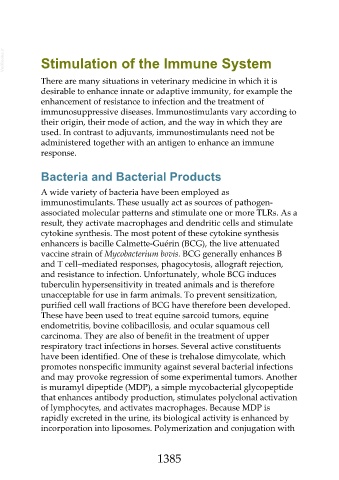Page 1385 - Veterinary Immunology, 10th Edition
P. 1385
VetBooks.ir Stimulation of the Immune System
There are many situations in veterinary medicine in which it is
desirable to enhance innate or adaptive immunity, for example the
enhancement of resistance to infection and the treatment of
immunosuppressive diseases. Immunostimulants vary according to
their origin, their mode of action, and the way in which they are
used. In contrast to adjuvants, immunostimulants need not be
administered together with an antigen to enhance an immune
response.
Bacteria and Bacterial Products
A wide variety of bacteria have been employed as
immunostimulants. These usually act as sources of pathogen-
associated molecular patterns and stimulate one or more TLRs. As a
result, they activate macrophages and dendritic cells and stimulate
cytokine synthesis. The most potent of these cytokine synthesis
enhancers is bacille Calmette-Guérin (BCG), the live attenuated
vaccine strain of Mycobacterium bovis. BCG generally enhances B
and T cell–mediated responses, phagocytosis, allograft rejection,
and resistance to infection. Unfortunately, whole BCG induces
tuberculin hypersensitivity in treated animals and is therefore
unacceptable for use in farm animals. To prevent sensitization,
purified cell wall fractions of BCG have therefore been developed.
These have been used to treat equine sarcoid tumors, equine
endometritis, bovine colibacillosis, and ocular squamous cell
carcinoma. They are also of benefit in the treatment of upper
respiratory tract infections in horses. Several active constituents
have been identified. One of these is trehalose dimycolate, which
promotes nonspecific immunity against several bacterial infections
and may provoke regression of some experimental tumors. Another
is muramyl dipeptide (MDP), a simple mycobacterial glycopeptide
that enhances antibody production, stimulates polyclonal activation
of lymphocytes, and activates macrophages. Because MDP is
rapidly excreted in the urine, its biological activity is enhanced by
incorporation into liposomes. Polymerization and conjugation with
1385

